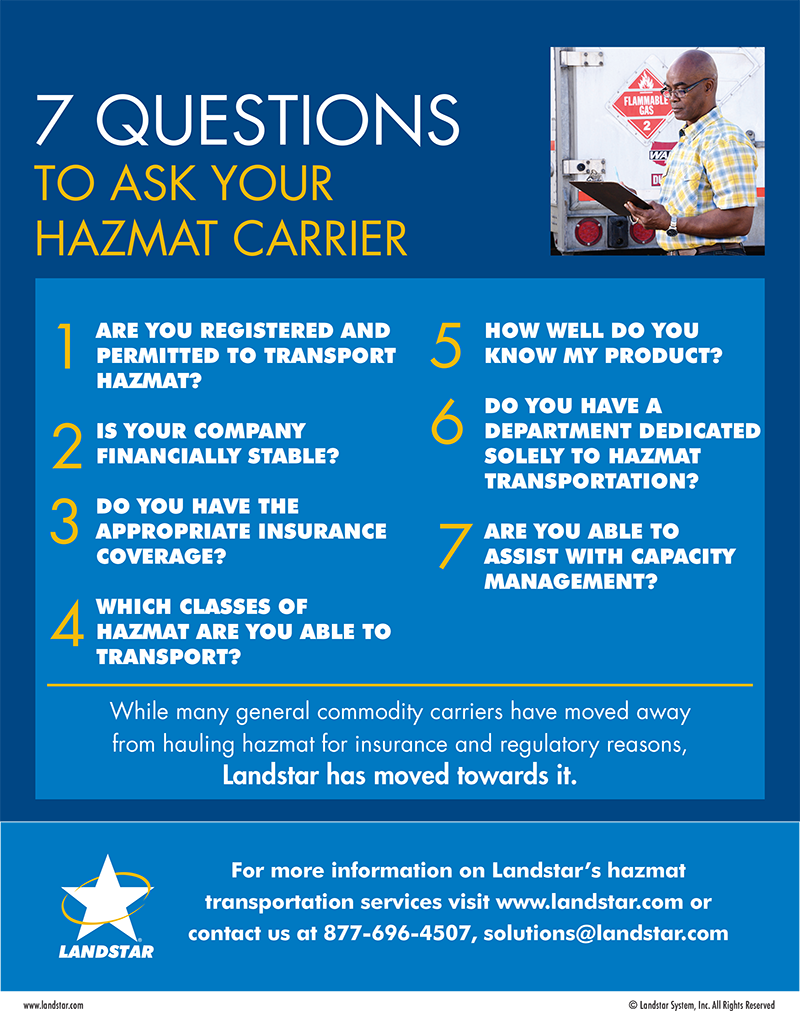Risks of Shipping Hazardous Materials

Customers, carriers and drivers play a major role in ensuring hazmat shipments are transported safely and compliantly.
Whether the goal is to prevent accidents, preserve human lives, minimize adverse consequences, or ensure a timely emergency response, the rules and regulations outlined by the laws governing the transportation of hazardous materials (hazmat) are complex and apply directly to shippers and carriers.
According to the Hazardous Materials Transportation Act (HMTA), whether shipping hazmat by highway, rail, air or water, any company whose goods fall into the hazmat category must adhere to these lawfully required or risk fines and penalties. Because shippers, carriers, and drivers all work together, it is important to know the risks to each if not compliant with the law.
Risk for Manufacturers / Shippers
- A principal risk when transporting hazardous materials is the potential for personal injury and property damage due to mishandling.
- Regulatory risks include exposure to potential civil penalties imposed by the US Department of Transportation (DOT), such as by the Pipeline and Hazardous Materials Safety Administration (PHMSA).
- Individual state violations can also occur.
- Based on incident circumstances, other government agencies such as Occupational Safety and Health Administration (OSHA) and the Environmental Protection Agency (EPA) could be involved.
- Other risks include the potential for negative impact viewed by the general public, potential loss of authority to ship hazardous materials, and potential loss of business.
The DOT has established guidelines for minimum and maximum civil penalties including if the violation results in death, serious illness, or severe injury to any person or substantial destruction of property. Individual states can and often impose fines, which vary by state.
Risk for Carriers
All of the above, plus unnecessary Compliance, Safety, Accountability (CSA) points, which are points assigned to a carrier by DOT based on violations received during roadside inspections.
Risk for Truck Owner-Operators and Drivers
Operators face the same monetary state and federal penalties shippers and carriers, plus the potential of suspension from transporting hazardous materials or loss of truck lease or employment with their trucking company.
Risk to the General public
The general public could encounter risk with an incident/accident involving a shipment of hazardous materials if in close proximity to a release of certain hazardous commodities.
There are nine different hazard classes/divisions of hazardous materials as provided by the Federal Motor Carrier Safety Administration (FMCSA). All hazard classes pose an equal risk of fines, penalties, and violations, whether the hazmat is from paint that falls under Class 3 Flammable Liquids, to Helium and Oxygen that falls under Class 2.2 Non-Flammable Gas.
It is important to understand that regulations require that a company shipping hazardous materials must offer compliant shipments to carriers and that carriers should only accept compliant shipments.
Shippers should vet the hazmat carriers they utilize on items ranging from (i) verification that the carrier is registered and permitted to transport hazmat; (ii) financially stable; (iii) properly insured with appropriate levels and coverages applicable to hazmat transportation; (iv) experienced personnel and (v) use of reputable carriers only that are knowledgeable in hazardous materials.
Article Topics
Landstar News & Resources
Unlocking Heavy/Specialized Success Freight Delivery is Only Part of the Logistics Solution Don’t Let These Carrier Mistakes Keep You Up At Night 2020 State of Logistics: Truckload Is Your Transportation Provider Meeting Your Needs? Commercial HVAC Systems Manufacturer Brings Its Innovation on Tour Manage Fuel Expenses at the Click of a Button More LandstarLatest in Transportation
Why are Diesel Prices Climbing Back Over $4 a Gallon? Luxury Car Brands in Limbo After Chinese Company Violates Labor Laws The Three Biggest Challenges Facing Shippers and Carriers in 2024 Supply Chain Stability Index: “Tremendous Improvement” in 2023 Trucking Association CEO on New Biden Policy: ‘Entirely Unachievable’ Two Weeks After Baltimore, Another Cargo Ship Loses Power By Bridge Examining the freight railroad and intermodal markets with Tony Hatch More Transportation














